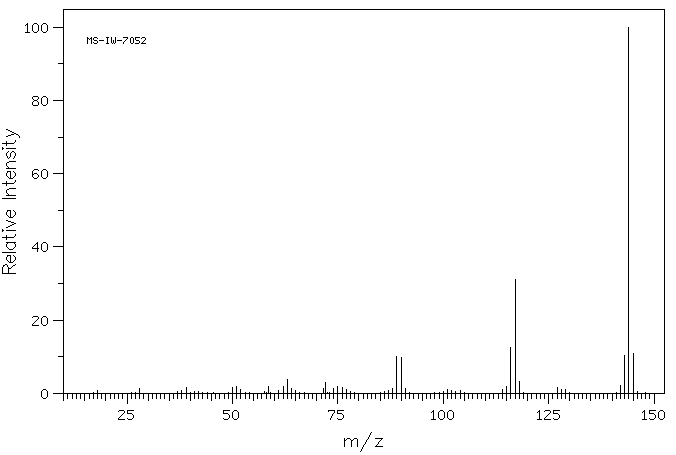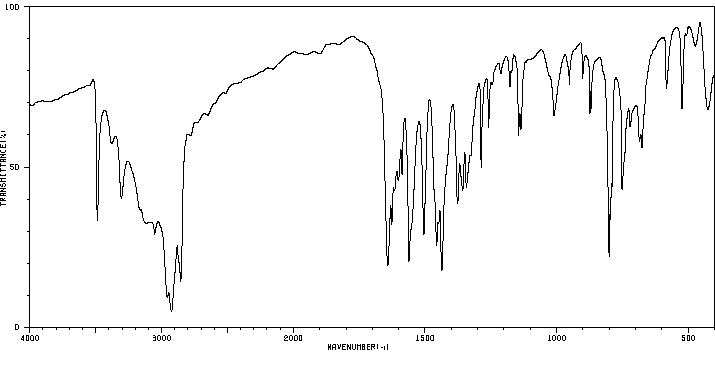1-氨基异喹啉 | 1532-84-9
-
物化性质
-
计算性质
-
ADMET
-
安全信息
-
SDS
-
制备方法与用途
-
上下游信息
-
文献信息
-
表征谱图
-
同类化合物
-
相关功能分类
-
相关结构分类
物化性质
-
熔点:122-124 °C (lit.)
-
沸点:166°C/8mmHg(lit.)
-
密度:1.1148 (estimate)
-
最大波长(λmax):335nm(H2O)(lit.)
-
稳定性/保质期:
在常温常压下保持稳定
计算性质
-
辛醇/水分配系数(LogP):1.9
-
重原子数:11
-
可旋转键数:0
-
环数:2.0
-
sp3杂化的碳原子比例:0.0
-
拓扑面积:38.9
-
氢给体数:1
-
氢受体数:2
安全信息
-
危险品标志:Xi
-
安全说明:S26,S37/39
-
危险类别码:R36/37/38
-
WGK Germany:3
-
海关编码:2933499090
-
储存条件:常温、避光、存放在通风干燥处。
SDS
模块 1. 化学品
1.1 产品标识符
: 1-氨基异喹啉
产品名称
1.2 鉴别的其他方法
无数据资料
1.3 有关的确定了的物质或混合物的用途和建议不适合的用途
仅用于研发。不作为药品、家庭或其它用途。
模块 2. 危险性概述
2.1 GHS-分类
皮肤刺激 (类别 2)
眼睛刺激 (类别 2A)
特异性靶器官系统毒性(一次接触) (类别 3)
2.2 GHS 标记要素,包括预防性的陈述
象形图
警示词 警告
危险申明
H315 造成皮肤刺激。
H319 造成严重眼刺激。
H335 可能引起呼吸道刺激。
警告申明
预防
P261 避免吸入粉尘/烟/气体/烟雾/蒸气/喷雾.
P264 操作后彻底清洁皮肤。
P271 只能在室外或通风良好之处使用。
P280 穿戴防护手套/ 眼保护罩/ 面部保护罩。
响应
P302 + P352 如皮肤接触:用大量肥皂和水清洗。
P304 + P340 如吸入: 将患者移到新鲜空气处休息,并保持呼吸舒畅的姿势。
P305 + P351 + P338 如与眼睛接触,用水缓慢温和地冲洗几分钟。如戴隐形眼镜并可方便地取
出,取出隐形眼镜,然后继续冲洗.
P312 如感觉不适,呼救中毒控制中心或医生.
P321 具体治疗(见本标签上提供的急救指导)。
P332 + P313 如发生皮肤刺激:求医/ 就诊。
P337 + P313 如仍觉眼睛刺激:求医/就诊。
P362 脱掉沾染的衣服,清洗后方可重新使用。
储存
P403 + P233 存放于通风良的地方。 保持容器密闭。
P405 存放处须加锁。
处置
P501 将内容物/ 容器处理到得到批准的废物处理厂。
2.3 其它危害物 - 无
模块 3. 成分/组成信息
3.1 物 质
: C9H8N2
分子式
: 144.17 g/mol
分子量
组分 浓度或浓度范围
Isoquinolin-1-amine
-
化学文摘登记号(CAS 1532-84-9
No.) 216-243-2
EC-编号
模块 4. 急救措施
4.1 必要的急救措施描述
一般的建议
请教医生。 向到现场的医生出示此安全技术说明书。
吸入
如果吸入,请将患者移到新鲜空气处。 如呼吸停止,进行人工呼吸。 请教医生。
皮肤接触
用肥皂和大量的水冲洗。 请教医生。
眼睛接触
用大量水彻底冲洗至少15分钟并请教医生。
食入
切勿给失去知觉者通过口喂任何东西。 用水漱口。 请教医生。
4.2 主要症状和影响,急性和迟发效应
据我们所知,此化学,物理和毒性性质尚未经完整的研究。
4.3 及时的医疗处理和所需的特殊处理的说明和指示
无数据资料
模块 5. 消防措施
5.1 灭火介质
灭火方法及灭火剂
用水雾,抗乙醇泡沫,干粉或二氧化碳灭火。
5.2 源于此物质或混合物的特别的危害
碳氧化物, 氮氧化物
5.3 给消防员的建议
如必要的话,戴自给式呼吸器去救火。
5.4 进一步信息
无数据资料
模块 6. 泄露应急处理
6.1 作业人员防护措施、防护装备和应急处置程序
使用个人防护用品。 避免粉尘生成。 避免吸入蒸气、烟雾或气体。 保证充分的通风。
人员疏散到安全区域。 避免吸入粉尘。
6.2 环境保护措施
不要让产品进入下水道。
6.3 泄漏化学品的收容、清除方法及所使用的处置材料
收集和处置时不要产生粉尘。 扫掉和铲掉。 放入合适的封闭的容器中待处理。
6.4 参考其他部分
丢弃处理请参阅第13节。
模块 7. 操作处置与储存
7.1 安全操作的注意事项
避免接触皮肤和眼睛。 避免形成粉尘和气溶胶。
在有粉尘生成的地方,提供合适的排风设备。一般性的防火保护措施。
7.2 安全储存的条件,包括任何不兼容性
贮存在阴凉处。 使容器保持密闭,储存在干燥通风处。
7.3 特定用途
无数据资料
模块 8. 接触控制和个体防护
8.1 容许浓度
最高容许浓度
没有已知的国家规定的暴露极限。
8.2 暴露控制
适当的技术控制
根据良好的工业卫生和安全规范进行操作。 休息前和工作结束时洗手。
个体防护设备
眼/面保护
带有防护边罩的安全眼镜符合 EN166要求请使用经官方标准如NIOSH (美国) 或 EN 166(欧盟)
检测与批准的设备防护眼部。
皮肤保护
戴手套取 手套在使用前必须受检查。
请使用合适的方法脱除手套(不要接触手套外部表面),避免任何皮肤部位接触此产品.
使用后请将被污染过的手套根据相关法律法规和有效的实验室规章程序谨慎处理. 请清洗并吹干双手
所选择的保护手套必须符合EU的89/686/EEC规定和从它衍生出来的EN 376标准。
身体保护
防渗透的衣服, 防护设备的类型必须根据特定工作场所中的危险物的浓度和数量来选择。
呼吸系统防护
如须暴露于有害环境中,请使用P95型(美国)或P1型(欧盟 英国
143)防微粒呼吸器。如需更高级别防护,请使用OV/AG/P99型(美国)或ABEK-P2型 (欧盟 英国 143)
防毒罐。
呼吸器使用经过测试并通过政府标准如NIOSH(US)或CEN(EU)的呼吸器和零件。
模块 9. 理化特性
9.1 基本的理化特性的信息
a) 外观与性状
形状: 粉末
颜色: 淡棕
b) 气味
无数据资料
c) 气味阈值
无数据资料
d) pH值
无数据资料
e) 熔点/凝固点
熔点/凝固点: 122 - 124 °C - lit.
f) 沸点、初沸点和沸程
无数据资料
g) 闪点
无数据资料
h) 蒸发速率
无数据资料
i) 易燃性(固体,气体)
无数据资料
j) 高的/低的燃烧性或爆炸性限度 无数据资料
k) 蒸气压
无数据资料
l) 蒸汽密度
无数据资料
m) 密度/相对密度
无数据资料
n) 水溶性
无数据资料
o) n-辛醇/水分配系数
无数据资料
p) 自燃温度
无数据资料
q) 分解温度
无数据资料
r) 粘度
无数据资料
模块 10. 稳定性和反应活性
10.1 反应性
无数据资料
10.2 稳定性
无数据资料
10.3 危险反应
无数据资料
10.4 应避免的条件
无数据资料
10.5 不相容的物质
强氧化剂
10.6 危险的分解产物
其它分解产物 - 无数据资料
模块 11. 毒理学资料
11.1 毒理学影响的信息
急性毒性
无数据资料
皮肤刺激或腐蚀
无数据资料
眼睛刺激或腐蚀
无数据资料
呼吸道或皮肤过敏
无数据资料
生殖细胞突变性
无数据资料
致癌性
IARC:
此产品中没有大于或等于 0。1%含量的组分被 IARC鉴别为可能的或肯定的人类致癌物。
生殖毒性
无数据资料
特异性靶器官系统毒性(一次接触)
吸入 - 可能引起呼吸道刺激。
特异性靶器官系统毒性(反复接触)
无数据资料
吸入危险
无数据资料
潜在的健康影响
吸入 吸入可能有害。 引起呼吸道刺激。
摄入 如服入是有害的。
皮肤 通过皮肤吸收可能有害。 造成皮肤刺激。
眼睛 造成严重眼刺激。
接触后的征兆和症状
据我们所知,此化学,物理和毒性性质尚未经完整的研究。
附加说明
化学物质毒性作用登记: 无数据资料
模块 12. 生态学资料
12.1 生态毒性
无数据资料
12.2 持久性和降解性
无数据资料
12.3 潜在的生物累积性
无数据资料
12.4 土壤中的迁移性
无数据资料
12.5 PBT 和 vPvB的结果评价
无数据资料
12.6 其它不良影响
无数据资料
模块 13. 废弃处置
13.1 废物处理方法
产品
将剩余的和不可回收的溶液交给有许可证的公司处理。
联系专业的拥有废弃物处理执照的机构来处理此物质。
与易燃溶剂相溶或者相混合,在备有燃烧后处理和洗刷作用的化学焚化炉中燃烧
受污染的容器和包装
按未用产品处置。
模块 14. 运输信息
14.1 联合国危险货物编号
欧洲陆运危规: - 国际海运危规: - 国际空运危规: -
14.2 联合国运输名称
欧洲陆运危规: 非危险货物
国际海运危规: 非危险货物
国际空运危规: 非危险货物
14.3 运输危险类别
欧洲陆运危规: - 国际海运危规: - 国际空运危规: -
14.4 包裹组
欧洲陆运危规: - 国际海运危规: - 国际空运危规: -
14.5 环境危险
欧洲陆运危规: 否 国际海运危规 国际空运危规: 否
海洋污染物(是/否): 否
14.6 对使用者的特别提醒
无数据资料
模块 15 - 法规信息
N/A
模块16 - 其他信息
N/A
制备方法与用途
上下游信息
-
上游原料
中文名称 英文名称 CAS号 化学式 分子量 —— N-(tert-butyl)isoquinolin-1-amine —— C13H16N2 200.283 1-硝基异喹啉 1-nitro-isoquinoline 19658-76-5 C9H6N2O2 174.159 异喹啉 isoquinoline 119-65-3 C9H7N 129.161 -
下游产品
中文名称 英文名称 CAS号 化学式 分子量 1-亚硝基异喹啉 1-nitrosoisoquinoline 79933-06-5 C9H6N2O 158.159 N-甲基异喹啉-1-胺 N-methylisoquinolin-1-amine 46000-11-7 C10H10N2 158.203 —— N-allyl-1-aminoisoquinoline 1314079-02-1 C12H12N2 184.241 1-氨基-4-溴异喹啉 4-bromoisoquinolin-1-amine 55270-27-4 C9H7BrN2 223.072 1-硝基异喹啉 1-nitro-isoquinoline 19658-76-5 C9H6N2O2 174.159 —— N-(isoquinolin-1-yl)acetamide 51640-00-7 C11H10N2O 186.213 —— N-benzylisoquinolin-1-amine 51336-09-5 C16H14N2 234.301 异喹啉 isoquinoline 119-65-3 C9H7N 129.161 —— N-isoquinolin-1-ylpropanamide 1354695-99-0 C12H12N2O 200.24 —— isoquinolin-1-yl-carbamic acid ethyl ester 36160-16-4 C12H12N2O2 216.239
反应信息
-
作为反应物:参考文献:名称:Nucleophilic displacement of primary amino groups via 1-substituted 4-tosylimidazoles摘要:DOI:10.1021/jo00132a013
-
作为产物:参考文献:名称:通过去质子铜化作用直接羟基化和胺化芳烃摘要:芳族/杂芳族 CH 键的去质子定向邻铜化和随后用 t-BuOOH 氧化以高产率和高区域选择性和化学选择性提供官能化酚。DFT 计算表明,这种羟基化反应是通过铜 (I → III → I) 氧化还原机制进行的。将该反应应用于使用 BnONH2 的芳族 CH 胺化有效地提供了相应的伯苯胺。这些反应显示出广泛的范围和良好的官能团兼容性。还展示了这些转化的催化版本。DOI:10.1021/jacs.6b03855
文献信息
-
Efficient one-pot transformation of aminoarenes to haloarenes using halodimethylisulfonium halides generated in situ作者:Woonphil Baik、Wanqiang Luan、Hyun Joo Lee、Cheol Hun Yoon、Sangho Koo、Byeong Hyo KimDOI:10.1139/v05-026日期:2005.3.1
Halodimethylsulfonium halide 1, which is readily formed in situ from hydrohaloic acid and DMSO, is a good nucleophilic halide. This activated nucleophilic halide rapidly converts aryldiazonium salt prepared in situ by the same hydrohaloic acid and nitrite ion to aryl chlorides, bromides, or iodides in good yield. The combined action of nitrite ion and hydrohaloic acid in DMSO is required for the direct transformation of aromatic amines, which results in the production of aryl halides within 1 h. Substituted compounds with electron-donating or -withdrawing groups or sterically hindered aromatic amines are also smoothly transformed to the corresponding aromatic halides. The only observed by-product is the deaminated arene (usually <7%). The isolated aryldiazonium salts can also be converted to the corresponding aryl halides using 1. The present method offers a facile, one-step procedure for transforming aminoarenes to haloarenes and lacks the environmental pollutants that usually accompany the Sandmeyer reaction using copper halides. Key words: aminoarenes, haloarenes, halodimethylsulfonium halide, halogenation, amination.
卤二甲基亚砜卤化物1是一种良好的亲核卤化物,可在现场由氢卤酸和二甲亚砜形成。这种活化的亲核卤化物迅速将由相同的氢卤酸和亚硝酸根在现场制备的芳基重氮盐转化为芳基氯化物、溴化物或碘化物,收率较高。在DMSO中,亚硝酸根和氢卤酸的联合作用是直接转化芳香胺的必要条件,从而在1小时内产生芳基卤化物。带有电子给体或吸引基团或有立体位阻的芳香胺的取代化合物也可顺利转化为相应的芳香卤化物。观察到的唯一副产物是去氨基芳烃(通常<7%)。孤立的芳基重氮盐也可以使用1转化为相应的芳基卤化物。该方法提供了一种简便的、一步法的程序,用于将氨基芳烃转化为卤代芳烃,并且不伴随通常伴随使用铜卤化物进行桑迈尔反应的环境污染物。关键词:氨基芳烃,卤代芳烃,卤二甲基亚砜卤化物,卤化,胺化。 -
Access to Imidazo[1,2-<i>a</i>]pyridines via Annulation of α-Keto Vinyl Azides and 2-Aminopyridines作者:Praveen Reddy Adiyala、Geeta Sai Mani、Jagadeesh Babu Nanubolu、Kunta Chandra Shekar、Ram Awatar MauryaDOI:10.1021/acs.orglett.5b02124日期:2015.9.4synthesis of imidazo[1,2-a]pyridines via efficient catalyst/metal-free annulations of α-keto vinyl azides and 2-aminopyridines is described. Several imidazo[1,2-a]pyridines were synthesized from readily available vinyl azides and 2-aminopyridines and obtained in highly pure form by simply evaporating the reaction solvent. This remarkably high yielding and atom economical protocol allows the formation of three
-
[EN] HEPATITIS C VIRUS INHIBITORS<br/>[FR] INHIBITEURS DU VIRUS DE L'HEPATITE C申请人:BRISTOL MYERS SQUIBB CO公开号:WO2003099274A1公开(公告)日:2003-12-04Hepatitis C virus inhibitors are disclosed having the general formula:(I) wherein R1, R2, R3, R', B, Y and X are described in the description. Compositions comprising the compounds and methods for using the compounds toinhibit HCV are also disclosed.丙型肝炎病毒抑制剂公开了具有以下通式:其中R1、R2、R3、R'、B、Y和X在描述中有所描述。还公开了包含该化合物的组合物以及使用该化合物抑制HCV的方法。
-
[EN] CORTISTATIN ANALOGUES AND SYNTHESES AND USES THEREOF<br/>[FR] ANALOGUES DE CORTISTATINE ET SYNTHÈSES ET UTILISATIONS ASSOCIÉES申请人:HARVARD COLLEGE公开号:WO2015100420A1公开(公告)日:2015-07-02Provided herein are compounds of Formula (A), (B), (C), (D) and (E), pharmaceutically acceptable salts, quaternary amine salts, and N-oxides thereof, and pharmaceutical compositions thereof. Compounds of Formula (A), (B), (C), (D), and (E) are contemplated useful as therapeutics for treating a wide variety of conditions, e.g., including but not limited to, conditions associated with angiogenesis and with CDK8 and/or CDK19 kinase activity. Further provided are methods of inhibiting CDK8 and/or CDK19 kinase activity, methods of modulating the β-catenin pathway, methods of modulating STAT1 activity, methods of modulating the TGFβ/BMP pathway, methods of modulating HIF-1 -alpha activity in a cell, and methods of increasing BIM expression to induce apoptosis, using a compound of Formula (A), (B), (C), (D), or (E). Further provided are CDK8 and CDK19 point mutants and methods of use thereof.本文提供了公式(A)、(B)、(C)、(D)和(E)的化合物、药用可接受的盐、季铵盐和N-氧化物,以及它们的药物组合物。公式(A)、(B)、(C)、(D)和(E)的化合物被认为是有用的治疗剂,用于治疗各种疾病,例如,包括但不限于,与血管生成和与CDK8和/或CDK19激酶活性相关的疾病。还提供了抑制CDK8和/或CDK19激酶活性的方法,调节β-连环蛋白途径的方法,调节STAT1活性的方法,调节TGFβ/BMP途径的方法,调节细胞中HIF-1α活性的方法,以及使用公式(A)、(B)、(C)、(D)或(E)的化合物增加BIM表达以诱导凋亡的方法。还提供了CDK8和CDK19点突变体及其使用方法。
-
Copper-Mediated Tandem C(<i>sp</i> <sup>2</sup> )-H Amination and Annulation of Arenes with 2-Aminopyridines: Synthesis of Pyrido-fused Quinazolinone Derivatives作者:Jidan Liu、Jinhui Zou、Jiawei Yao、Guoshu ChenDOI:10.1002/adsc.201701286日期:2018.2.15An efficient and convenient copper‐mediated tandem C(sp2)‐H amination and annulation of arenes with 2‐aminopyridines to provide 11H‐pyrido[2,1‐b]quinazolin‐11‐ones has been developed. A variety of benzamides and 2‐aminopyridines bearing different substituents are compatible with this transformation
表征谱图
-
氢谱1HNMR
-
质谱MS
-
碳谱13CNMR
-
红外IR
-
拉曼Raman
-
峰位数据
-
峰位匹配
-
表征信息









